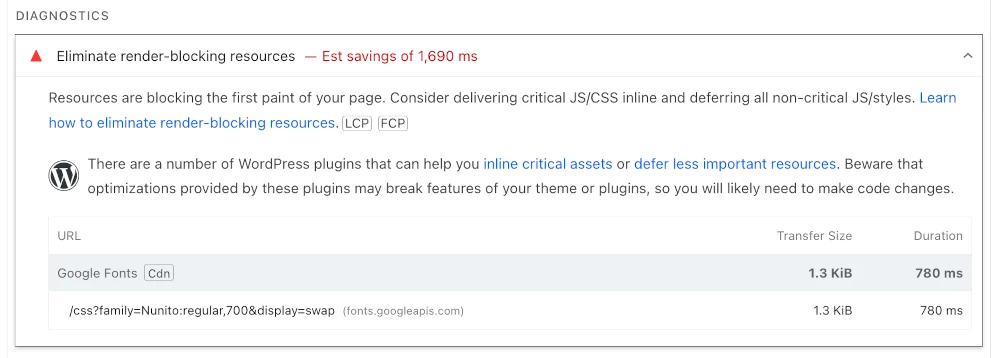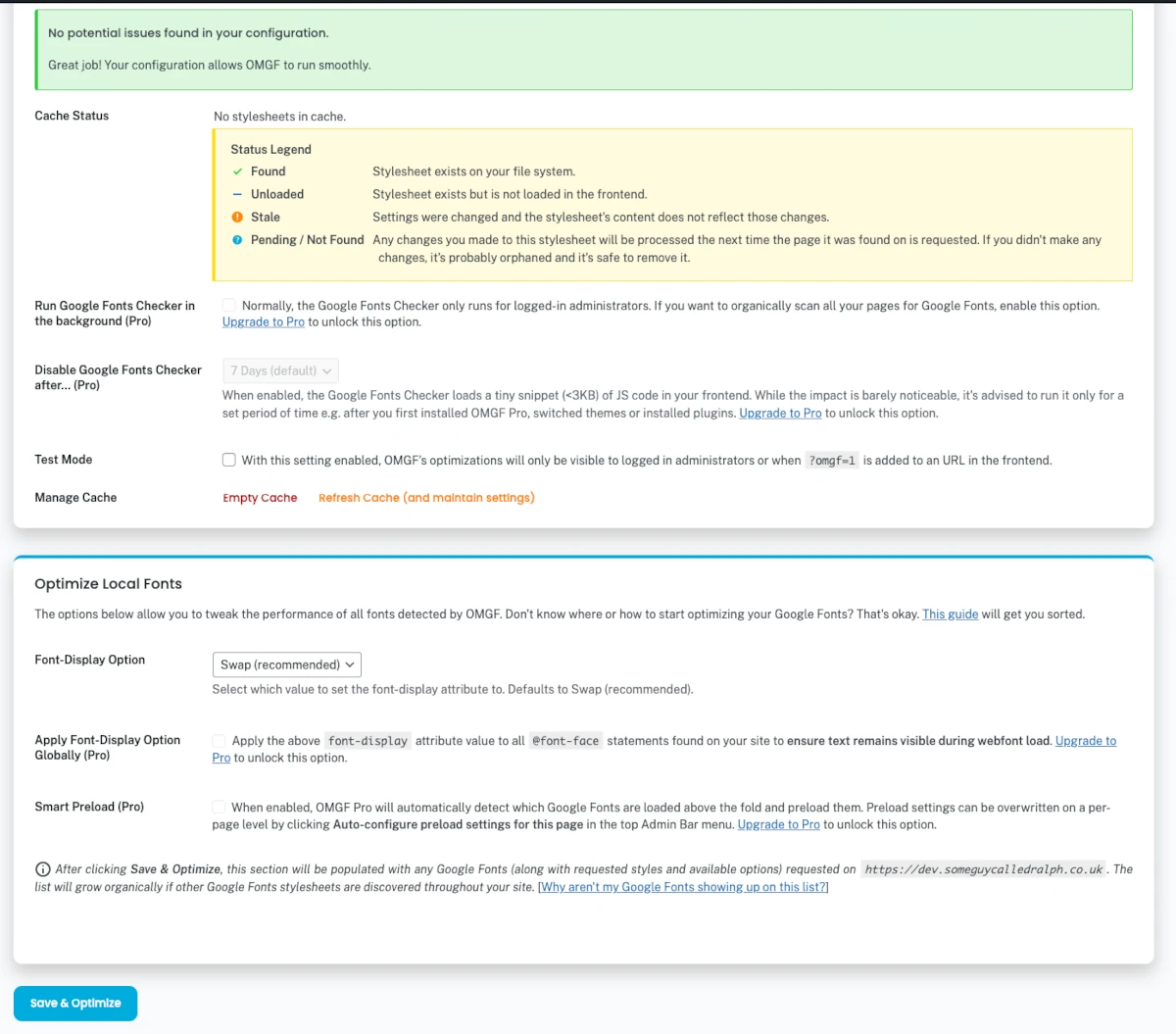Google fonts are great! I mean LOOK AT THEM ALL!!! All these fonts, for free! That’s amazing thanks Google!…. Oh, wait, what’s this in my pagespeed insight report!? RENDER BLOCKING RESOURCES from fonts.googleapis.com?!? Noooooooo! It’s like Google complaining about Google!

Well, not quite, and who cares? Here’s how to optimise Google fonts when using WordPress.
What are Google Fonts?
Google Fonts is a free library of over a thousand open source fonts that can be easily integrated into websites. This allows website owners can choose from a wide range of modern typefaces to match their brand and design.
In WordPress, themes and page builders often make it simple to add Google Fonts with just a few clicks, and the fonts are delivered via Google’s fast content delivery network (CDN).
This flexibility allows for greater creativity and improved readability, but it also introduces additional requests to external servers, which can impact page load speed if not optimised properly.
Why Google Fonts are great!
Google Fonts has become the go to choice for many WordPress users because it combines style, simplicity, and ease of use.
The library is completely free to use and offers an enormous variety of typefaces of approximately 1,849 font families (of which 492 are variable font families) from elegant serifs to modern sans-serifs and playful display fonts.
Google Fonts integrates seamlessly with most WordPress themes and plugins, making it easy to enhance your site’s design without any technical hassle.
The bad things that can happen when using Google Fonts in WordPress.
While Google Fonts is a powerful tool, it isn’t without implications and pitfalls. Every time your website loads fonts from Google’s servers, it adds extra HTTP requests, which can slow down your site.
Fonts are also render blocking resources, meaning your page may delay displaying text until the font has been downloaded. This can lead to layout shifts or a “flash of invisible text” (FOIT) if the browser is waiting too long, which is frustrating for visitors.
Why different bad things can happen when using Google Fonts in WordPress.
The problems with Google Fonts usually arise because of how WordPress themes and plugins implement them.
Many themes load multiple font weights and styles by default, even if you don’t use them, which adds unnecessary bloat.
Some page builders may call Google Fonts in inefficient ways, creating duplicate requests.
Fonts hosted on Google’s CDN are loaded from third-party servers, which can involve issues like regional privacy concerns (e.g., GDPR), server delays, or the overhead of loading of an external resource.
The effect of the bad things that can happen.
When these issues stack up, the impact on your site can be significant.
Slower font loading can decrease performance scores in tools like Google PageSpeed Insights and negatively affect Core Web Vitals such as Largest Contentful Paint (LCP) and Cumulative Layout Shift (CLS).
Beyond the technical scores, visitors may experience delays in seeing readable text or encounter distracting font changes mid-load.
Over time, the combination of all of the above can negatively affect user experience, increase bounce rates, and even affect SEO rankings if search engines view your site as slow or unstable.
How to optimise Google Fonts in WordPress.
Optimising Google Fonts is all about reducing the delay between when a page loads and when your visitors actually see the text styled correctly.
Since fonts are render-blocking resources, handling them efficiently can have a big impact on site speed and user experience.
In WordPress, there are several ways to improve how Google Fonts are delivered, from adjusting how browsers connect to Google’s servers (using techniques like DNS prefetch and preconnect), to limiting the number of font weights and styles you load, or even hosting the fonts locally on your own server.
By applying the right optimisation methods, you can keep your site looking professional and on-brand while also improving Core Web Vitals, page load times, and SEO performance.
DNS Prefetch for Google Fonts in WordPress.
DNS prefetch is a browser hint that tells the browser to resolve the domain name of an external resource before it’s actually requested, reducing the time it takes to establish a connection later. For Google Fonts, this can help speed up font loading slightly by performing the DNS lookup early. In WordPress, you can add DNS prefetch with a simple HTML snippet in your website’s head section:
<link rel="dns-prefetch" href="//fonts.googleapis.com">
<link rel="dns-prefetch" href="//fonts.gstatic.com">One easy way to add this HTML is by using the Insert Headers and Footers plugin, which lets you inject custom code into your site’s head section without editing theme files.
Pros:
- Simple to implement and lightweight.
- Reduces DNS lookup time for external font servers.
- Improves perceived page load speed slightly, especially for first-time visitors.
Cons:
- Only resolves the domain name; it doesn’t open a connection or do TLS handshakes.
- Provides a smaller performance benefit compared with more advanced methods like preconnect.
- Effect is minimal if the user has already visited other sites using Google Fonts, as the domain may already be cached.
Preconnect for Google Fonts in WordPress.
Preconnect is a browser hint that goes beyond DNS prefetch: it not only resolves the domain name but also initiates the TCP handshake and TLS negotiation with the server before the resource is requested.
This is especially useful for Google Fonts, because fonts are render-blocking resources and establishing the connection early reduces the delay in text rendering.
In WordPress, you can add preconnect with the following HTML snippet in your head section:
<link rel="preconnect" href="https://fonts.googleapis.com" crossorigin>
<link rel="preconnect" href="https://fonts.gstatic.com" crossorigin>A simple way to add this code is via the Insert Headers and Footers plugin, which lets you safely insert scripts and links into your site’s header without editing theme files.
Pros:
- Significantly reduces connection latency for critical resources like fonts.
- Improves Core Web Vitals, particularly Largest Contentful Paint (LCP).
- Simple to implement and compatible with most themes and plugins.
Cons:
- Only useful if you are actually loading Google Fonts; unnecessary preconnect hints do nothing but add extra HTML.
- Slightly increases HTTP request headers due to the crossorigin attribute, though the impact is negligible.
- Preconnect alone doesn’t reduce font file size—additional optimisations (like limiting font weights or local hosting) may still be needed for maximum speed.
Localising Google Fonts in WordPress.
Localising Google Fonts involves downloading the font files and serving them directly from your own web hosting account, instead of fetching them from Google’s servers.
This approach improves performance by reducing external HTTP requests and eliminating reliance on third-party servers, which can vary in response time depending on location.
Localising Google Fonts also helps with privacy compliance, such as GDPR, because user data isn’t sent to Google when fonts are loaded.
To implement this in WordPress, you can use plugins like OMGF (Optimize My Google Fonts), which automatically downloads the fonts your theme or plugins use and generates the proper CSS to serve them locally.
It’s just a case of installing and activating OMGF, the accessing it’s settings and provided you see the green check, click the “save & optimise” button:

Pros:
- Faster font loading, especially for repeat visitors, since fonts are cached locally.
- Reduces render-blocking requests from external servers, improving Core Web Vitals like LCP.
- Helps meet privacy regulations by avoiding external requests to Google.
Cons:
- Slightly more complex to set up than simple preconnect or DNS prefetch.
- Requires occasional updates if you add new fonts or styles to your site.
- Increases your server storage and bandwidth usage slightly, though usually negligible.
- Caching considerations: If you copy, clone, or migrate your site, you may need to purge caches or reconfigure the font paths to ensure they load correctly.

Summary: Optimising Google Fonts in WordPress.
Optimising Google Fonts in WordPress is about balancing performance, user experience, and privacy.
DNS prefetch allows browsers to resolve font domains early, preconnect goes a step further by establishing connections and TLS handshakes in advance, and localising fonts eliminates external requests entirely by serving them from your own server.
Together, these methods can reduce font-loading delays, improve Core Web Vitals like LCP and CLS, and ensure compliance with privacy regulations. Implementing them strategically—through lightweight HTML snippets or dedicated plugins—lets your site maintain its visual style without sacrificing speed or reliability.
FAQ: Optimising Google Fonts in WordPress.
What are Google Fonts?
Google Fonts is a free library of over a thousand open-source fonts that can be easily integrated into websites. It allows website owners to choose from a wide range of modern typefaces to match their brand and design. In WordPress, themes and page builders often make it simple to add Google Fonts with just a few clicks, and the fonts are delivered via Google’s fast content delivery network (CDN).
Why are Google Fonts great?
Google Fonts offers style, simplicity, and ease of use. With approximately 1,849 font families (including 492 variable fonts), it provides a wide variety from elegant serifs to modern sans-serifs and playful display fonts. Google Fonts integrates seamlessly with most WordPress themes and plugins, making it easy to enhance your site’s design without technical hassle.
What are the drawbacks of using Google Fonts in WordPress?
Loading Google Fonts from Google’s servers adds extra HTTP requests, which can slow your site. Fonts are render-blocking, which may delay displaying text and cause layout shifts or a “flash of invisible text” (FOIT). Themes and plugins may load unnecessary font weights or duplicate requests, and external hosting can create privacy concerns or variable server response times.
How do these issues affect my website?
Slower font loading can reduce performance scores in tools like Google PageSpeed Insights and negatively impact Core Web Vitals such as LCP and CLS. Visitors may experience delayed text rendering or distracting font changes, which can hurt user experience, increase bounce rates, and even affect SEO rankings.
How can I optimise Google Fonts in WordPress?
Optimising Google Fonts involves reducing the delay between page load and when text is displayed. Techniques include using DNS prefetch to resolve font domains early, preconnect to establish connections and TLS handshakes in advance, limiting font weights and styles, and hosting fonts locally. These steps improve speed, Core Web Vitals, and privacy compliance.
What is DNS prefetch for Google Fonts?
DNS prefetch tells the browser to resolve the domain of an external resource early. Example HTML:
<link rel="dns-prefetch" href="//fonts.googleapis.com">
<link rel="dns-prefetch" href="//fonts.gstatic.com">You can add this with plugins like Insert Headers and Footers.
Pros: Lightweight, reduces DNS lookup time, slightly improves perceived load speed.
Cons: Only resolves the domain name; does not open a connection or TLS handshake. Limited benefit if fonts are cached.
What is preconnect for Google Fonts?
Preconnect initiates DNS lookup, TCP handshake, and TLS negotiation before requesting fonts, reducing render-blocking delays. Example HTML:
<link rel="preconnect" href="https://fonts.googleapis.com" crossorigin>
<link rel="preconnect" href="https://fonts.gstatic.com" crossorigin>Pros: Reduces latency, improves Core Web Vitals, simple to implement.
Cons: Only helps if fonts are loaded; slightly increases request headers. Does not reduce font file size.
How do I localise Google Fonts in WordPress?
Localising Google Fonts means hosting the font files on your server instead of Google’s CDN. Plugins like OMGF (Optimize My Google Fonts) can automate this.
Pros: Faster font loading, improves Core Web Vitals, GDPR-friendly.
Cons: Slightly more complex, requires updates if fonts change, uses some server storage, and you may need to purge caches when migrating or cloning your site.
What is the overall benefit of these optimisations?
Combining DNS prefetch, preconnect, and local hosting reduces font-loading delays, improves Core Web Vitals, and ensures privacy compliance. Implementing these strategies keeps your site visually appealing without sacrificing speed, reliability, or SEO performance.
What are the best tips for maximum Google Fonts optimisation?
To get the most performance from Google Fonts in WordPress:
Limit font weights and styles – only load the ones your site actually uses.
Use DNS prefetch and preconnect – establish connections to Google’s servers early.
Localise fonts – host them on your own server to reduce external requests and improve privacy compliance.
Combine font requests – avoid multiple font calls; load all required styles in one request if possible.
Use font-display: swap – ensures text is shown with a fallback font until the Google Font loads, preventing invisible text (FOIT).







